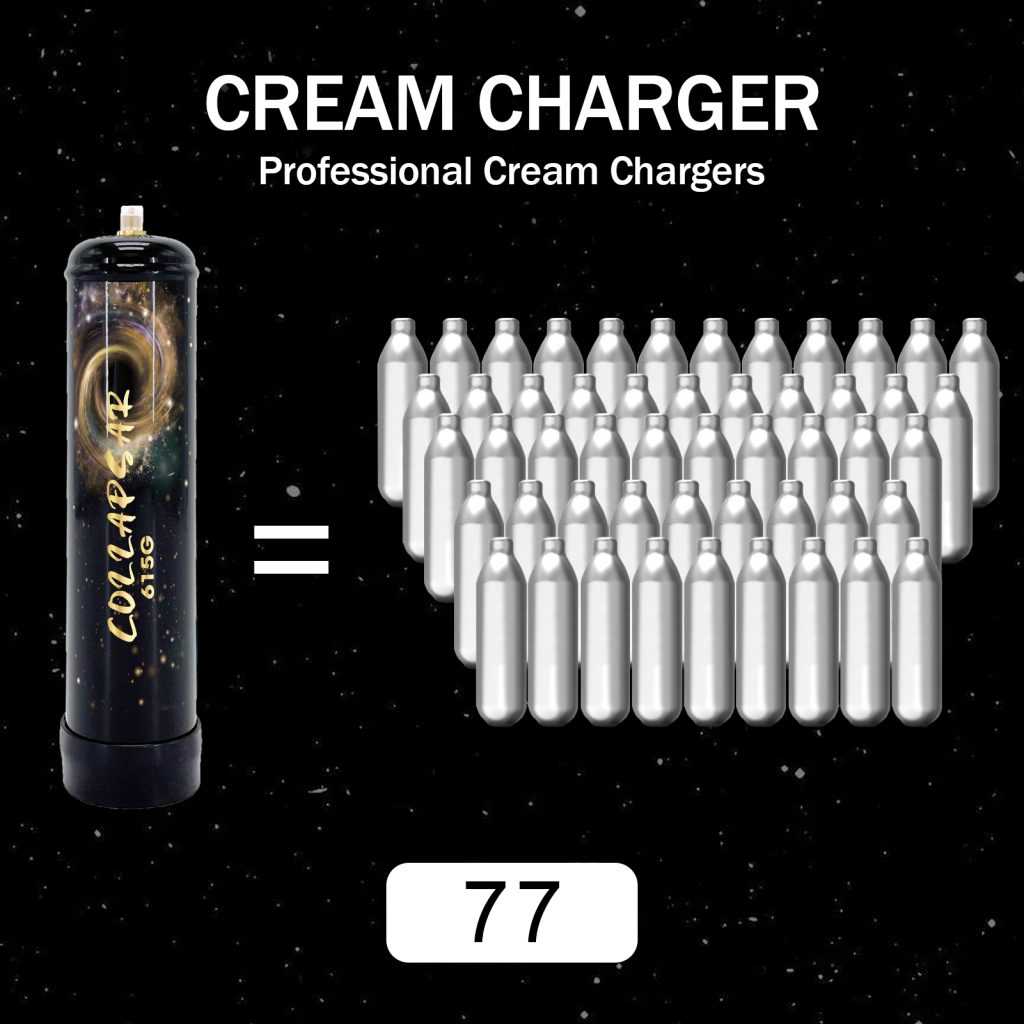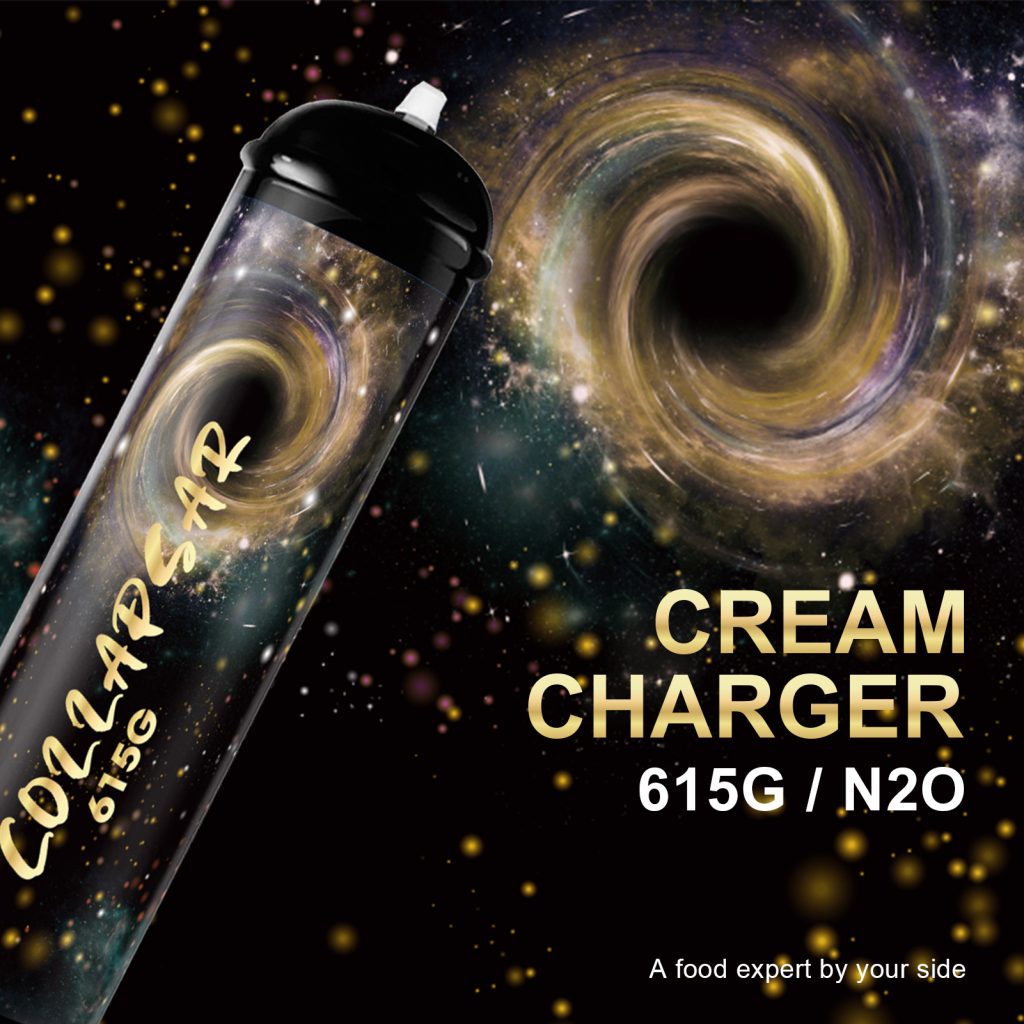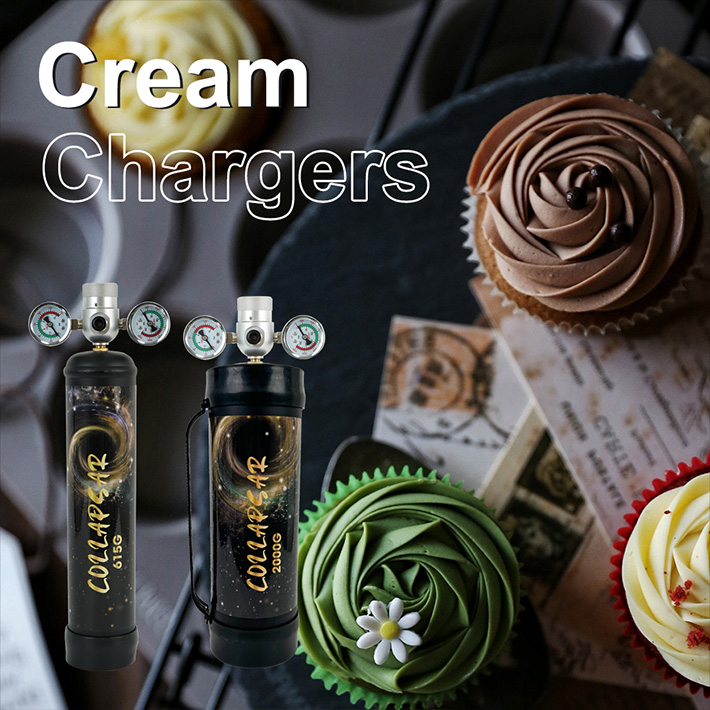Imagine whipping up a delicious dessert, only to find your cream flat and uninspired. The world of culinary arts constantly evolves, and with it comes a new player: nitrous oxide (N2O) tanks, revolutionizing the way we create whipped cream and infusions.
Traditional whipped cream chargers have served their purpose, but N2O tanks offer distinct advantages in both home and professional kitchens. From enhanced efficiency to greater versatility, understanding these benefits can elevate your culinary experience.
This article will explore the features, safety guidelines, and purchasing options for N2O tanks, ultimately making a case for why they may be the superior choice for your whipping and infusion needs.
Benefits of N2O Tanks in Culinary Applications
Nitrous oxide tanks are changing how chefs work in kitchens. These tanks hold the same amount of N2O as 77 cream chargers. This helps reduce waste and is better for the environment. Using a tank is more cost-effective than using many small cylinders. This is because tanks are lighter and cheaper to make and transport.
One big advantage of these tanks is that they let you control how much gas is released. This improves efficiency in cooking by speeding up the charging of siphons. The practical use of tanks in culinary settings allows chefs to create a wide range of dishes. Food-grade nitrous oxide ensures safety and quality. This helps cooks produce high-quality dishes and desserts.

Whipping Cream with N2O
Whipping cream with nitrous oxide is popular in many kitchens. N2O is a colorless, odorless gas that dissolves into cream, making it fluffy and light. Products like the Collapsargas N2O Cylinder offer food-grade nitrous oxide. This type of gas is great for culinary uses like whipping cream.
To make whipped cream, start by pouring heavy cream into a dispenser. Add sweeteners and flavors to your liking. Then, attach the N2O cylinder and shake the dispenser well. When you press the dispenser, the pressure release makes the cream expand. The result is a light, fluffy whipped cream that keeps its texture for a long time. N2O is not just for cream; it can also create flavored foams when used with other liquids.
Culinary Infusions using N2O
Nitrous oxide is also helpful for infusing flavors into liquids. You can use a whipped cream dispenser to mix liquids with herbs, spices, or fruits under pressure. For example, place basil or cinnamon with a liquid, like oil or alcohol, in the dispenser. The pressure from the N2O quickly transmits the essence of the flavors.
This method is much faster than traditional infusion techniques. It helps chefs add unique flavors to their dishes without waiting for long periods. These fast infusions can enhance sauces, dressings, and more. The technique brings an added depth of flavor that improves many culinary creations.
Key Features of N2O Tanks
N2O tanks are crucial for culinary experts who want to create stunning desserts and dishes. These tanks work with cream chargers to ensure high-quality results. The gas inside, nitrous oxide, is stable at room temperature. However, it can support combustion under certain conditions. To prevent dangerous over-pressurization, safety mechanisms like a safety relief disk are standard. This disk releases pressure at a set point to maintain safety. Managing the tank’s temperature is also vital, as too much heat can increase pressure beyond safe levels. Reputable distributors, such as Collapsargas, offer bulk purchasing services. This allows users to have reliable access to N2O, ensuring smooth operations.
Size and Capacity of N2O Tanks
N2O tanks come in many sizes, some holding up to 30,000 pounds or more. Their size directly affects how they’re used, whether in the culinary field or medical industries. Refilling these tanks is simple, often done through an online form or direct service contact. Providers assess customer needs, location, and operational requirements for timely service. Companies like Collapsargas use a wide network of distributors to speed up the refill process, making it efficient and hassle-free.
Material Durability and Safety Standards
Safety is a top priority for nitrous oxide tanks. They come with a safety relief disk located below the bottle valve. This disk breaks at a specific pressure to safely release bottled gas if over-pressurization occurs. At race tracks, an optional blowdown tube is crucial. It vents the nitrous oxide outside the car, reducing inhalation risks. Proper handling of nitrous oxide is essential, as misuse can be hazardous. While nitrous oxide is not flammable, it can enhance combustion under controlled conditions. Safety data sheets highlight potential toxicity, making understanding safety measures vital for users.
Compatibility with Whipping Equipment
Collapsargas cylinders are compatible with most whipped cream dispensers, making them ideal for both home and professional kitchens. A 20 lb. tank of nitrous oxide is versatile and works with any cream dispenser, offering a universal solution. Collapsargas chargers are designed for all professional whipped cream makers. The innovative design of 615-gram N2O cylinders allows easy connection to cream dispensers, ensuring a safe and efficient process. Collapsargas canisters meet International Manufacturing Standards, making them reliable for any compatible cream dispenser. This ensures they’re a fit for a wide range of whipping equipment.
Comparing N2O Tanks and Standard Cream Chargers
N2O tanks, like the 640g and 2000g models, hold much more nitrous oxide than standard cream chargers. The 2000g tank offers approximately 250 times more refills. These tanks use culinary-grade nitrous oxide, which ensures higher quality in meals, desserts, and drinks. Larger tanks improve efficiency for both home bakers and mixologists. They provide repeated, consistent usage without frequent replacements. Economically, larger N2O tanks like the 2000g model can be cheaper over time compared to many small chargers. Brands like Collapsargas deliver reliable performance and purity, often superior to standard chargers.
Logistical Advantages of Larger Tanks
Buying a nitrous oxide tank is cost-effective, equaling about 77 single cream charger cylinders. This reduces the need for frequent orders, simplifying inventory management. Businesses save on delivery costs by ordering less often. Tanks require less storage space than multiple packs of cartridges. Brands like Collapsargas offer bulk buying options, which further decrease costs.
Cost-Effectiveness of Bulk Purchasing
Bulk purchasing of nitrous oxide cylinders offers substantial savings. Discounts can range from 34% to 43%, depending on how much is bought. Collapsargas chargers have a longer shelf life due to airtight seals, allowing for bulk purchases without potency loss. Larger tanks provide full control over consumption and are more lucrative than single chargers. Buying in bulk cuts the per-unit cost, making it ideal for high-volume users like chefs and bakers.
User-Friendliness for Home and Professional Use
Nitrous oxide tanks are practical for both home and professional culinary tasks. They enable the production of expert-level desserts. Using nitrous oxide in whipped cream dispensers helps maintain a fluffy texture. Chefs can create airy foams from various liquids, making it versatile. Bulk buying not only reduces costs but also simplifies inventory. Brands like Collapsargas offer competitive pricing, making it accessible and affordable for many users.
| Feature | N2O Tanks | Standard Cream Chargers |
|---|---|---|
| Refill Capacity | High | Low |
| Nitrous Oxide Quality | Culinary-grade | Varies |
| Cost Efficiency | More economical in bulk | Depends on usage |
| Storage and Logistics | Space-saving | Requires more storage |
| User Experience | Consistent | Inconsistent |
In summary, N2O tanks provide numerous benefits over standard cream chargers, including cost savings, ease of storage, and improved quality for culinary applications. These advantages make them an excellent choice for both home use and professional kitchens.
Safety Guidelines for N2O Usage
Nitrous oxide, often used in culinary and medical settings, can pose risks if not handled correctly. Following safety guidelines helps prevent accidents and ensures effective use.
Proper Handling and Storage
Handling nitrous oxide tanks requires care. Store them upright and secure them to prevent tipping. Do not keep them near flammable materials or in poorly ventilated areas. Label cylinders properly and monitor expiration dates. Expired or damaged cylinders must be disposed of safely to maintain safety.
Proper Storage Tips:
- Store upright and secure
- Avoid flammable materials
- Cap and label cylinders
- Monitor expiration dates
Safety Gear and Precautions
Always follow the manufacturer’s instructions for any nitrous oxide equipment. Ensure the area is well-ventilated to prevent gas accumulation and asphyxiation risks. Direct inhalation from cartridges or dispensers is dangerous and should be avoided. Nitrous oxide tanks must include a safety relief disk to avoid over-pressurization and potential hazards.
Safety Equipment:
- Safety relief disk on tanks
- Well-ventilated usage area
- Follow manufacturer guidelines
- Avoid direct inhalation
Recognizing Signs of Overuse or Malfunction
Understanding signs of overuse or malfunction is crucial. Listen for unusual sounds or check for leaks in your devices. If gas is not flowing smoothly or there is irregular pressure, seek professional advice. Address any issues immediately to prevent health risks or equipment damage.
Signs to Watch for:
- Unusual noises
- Gas leaks
- Irregular pressure
- Professional inspection needed
By adhering to these guidelines, you ensure the safe and effective use of nitrous oxide in all applications.
Disposal and Environmental Considerations
When dealing with nitrous oxide tanks and cartridges, proper disposal is crucial to avoid environmental and safety hazards. Incorrect disposal can lead to dangerous situations, such as explosions or contamination. Regular checks using soapy water can help detect leaks and ensure safety. It’s also vital to have safety equipment like fire extinguishers and first-aid kits on hand. Trained personnel should handle and dispose of nitrous oxide equipment to minimize potential environmental impacts.
Guidelines for Safe Disposal of N2O Tanks
Proper disposal of nitrous oxide cylinders is essential. Always follow local regulations and guidelines to avoid potential hazards. Never throw these cans in the trash or recycling bin. Do not puncture or incinerate them, as this could be dangerous. Instead, use the recommended disposal methods to prevent environmental contamination. Check local rules, as they may have specific requirements for nitrous oxide disposal.
Environmental Impact of Nitrous Oxide
Nitrous oxide (N2O) presents notable environmental concerns. Though non-combustible, it can intensify fires if nearby combustibles ignite. Heat exposure can lead to violent container ruptures, risking human safety and the environment. N2O vapors are heavier than air, causing localized oxygen depletion, which affects both humans and animals. Prolonged exposure may lead to health issues, including oxygen deprivation and neurological disturbances, affecting ecosystems and human health.
Refilling N2O Tanks
Refilling nitrous oxide tanks is essential for various industries, including culinary, medical, and automotive fields. collapsargas Products offers efficient solutions to keep your operations running smoothly. By partnering with a national network of distributors, they ensure quick and reliable service. Here’s how you can refill your tank.
Process for Refilling Nitrous Oxide Tanks
- Gather Information: Begin by providing details about your tank size and operational needs. This information helps tailor the refill order to your requirements.
- Place an Order: Use the convenient online form provided by collapsargas Products to order a refill. You can also contact their team directly if you prefer personal assistance.
- Choose Quantities: Collapsargas offers nitrous oxide in large quantities, even up to 30,000 pounds, to meet extensive operational demands.
- Schedule Delivery: With their nationwide distribution network, Collapsargas ensures nitrous oxide is delivered according to your schedule.
The process is designed to accommodate different needs, whether for food-grade nitrous oxide in a cream dispenser or medical-grade nitrous for procedures.
Finding Refill Stations
Finding stations to refill your N2O tank yourself can be tricky. Here’s why professional assistance is often the better choice:
- Complex and Risky: Self-refilling can be complicated and poses potential hazards without expert oversight.
- Professional Assistance: collapsargas Products simplifies this with their user-friendly online form and direct contact options.
- Avoid Delays: Working with professionals ensures fast service and prevents long wait times.
- Extra Support: Besides refills,Collapsargas offers safety training and seminars, helping you manage health risks and understand your nitrous oxide system better.
Opting for a professional refill service ensures safety and efficiency, allowing you to focus on your core operations without worry.
Purchasing N2O Tanks
Nitrous oxide tanks, or N2O tanks, come in various sizes such as 5 lb., 10 lb., 15 lb., and 20 lb. cylinders. Prices for these tanks can range from $350 to $600, depending on the size and purchase option. You can choose to lease a tank, which involves a deposit and return shipping, or buy it outright. Outright purchases might offer refill options by mail. Additionally, large nitrous oxide tanks are available over the counter at places like head shops and corner stores. However, there are talks of regulation due to safety and misuse concerns, like the proposed bill by State Representative Joe Stagni in Louisiana to ban their sale.
Recommended Retailers for N2O Tanks
One popular retailer for nitrous oxide tanks is Collapsargas. They offer tanks with 640 grams of nitrous oxide for both individual and wholesale purchases. Customers enjoy the convenience of having tanks shipped directly to their destination. Collapsargas and similar retailers highlight the practicality of buying tanks over single-use cylinders, focusing on quality and fast shipping. This ensures customer satisfaction and long-term cost-effectiveness.
Online vs. In-store Purchasing
Purchasing nitrous oxide tanks online offers the convenience of ordering from businesses like Collapsargas. It allows businesses to buy in bulk, often at wholesale prices, and have the tanks delivered directly. Online purchasing also gives users full control over their consumption, unlike buying single-use cylinders in-store. While head shops and corner stores may provide over-the-counter sales, online shopping could help avoid legal issues, especially in areas with strict regulations on nitrous oxide sales.
Frequently Asked Questions about N2O Tanks
Nitrous oxide (N2O) tanks are essential tools in culinary arts, mainly when used with a cream charger. They help create perfect desserts by aiding in whipping creams and foams. An important component of N2O tanks is the safety relief disk, which prevents over-pressurization. Storing these tanks correctly means keeping them out of direct sunlight and heat sources. Though failures are rare, improper storage can be risky. Legal concerns about nitrous oxide have prompted discussions on stricter regulation for its sale and use.
Common Misconceptions about N2O
Despite nitrous oxide’s popularity for recreational inhalation, it’s risky and not recommended. The gas may cause health risks under improper use. Protective gear like gloves and safety glasses are crucial when handling N2O to avoid injuries like frostbite. Storage is vital—keep N2O in a cool, dry area away from children. While it’s not flammable, nitrous oxide can aid combustion, but not as much as oxygen does. Routine checks, like using soapy water, are crucial to detect leaks in nitrous oxide equipment.
Clarifying Legal Regulations for N2O Use
In Louisiana, selling nitrous oxide is legal if it’s not intended for intoxication. Yet, new laws might ban large N2O tanks completely. A bill by State Representative Joe Stagni could redefine these legal limits. Ventilation is key when using N2O to avoid dangerous gas buildup. In New York, having N2O for recreational inhale is illegal. Buyers should be aware of N2O risks, including potential toxicity and legal issues.
Alternative Uses of N2O Beyond Culinary
Nitrous oxide has versatile applications beyond food. It acts as a propellant due to its pressure-building properties. In industries, it’s used as a cryogenic refrigerant for its cooling effects. In the auto world, N2O boosts engine performance by providing oxygen to the fuel-air mix. Historically, it also served as an anesthetic in dental surgeries. Its stability at room temperature makes nitrous oxide a reliable compound for various uses without extensive safety measures.
Conclusion and Final Thoughts on N2O Tanks
In conclusion, nitrous oxide (N2O) tanks play a vital role in both the culinary and medical fields. These tanks are highly valued in kitchens worldwide for their ability to improve the texture and aeration of desserts and whipped cream. They originated in dental anesthesia and expanded to various medical uses due to N2O’s stable and anesthetic properties.
Safety is paramount when storing these tanks. Ensure they are kept in a cool, dry, and well-ventilated area, away from direct sunlight and heat sources. This precaution helps prevent any potential hazards.
A wide range of high-quality N2O cylinders is available in different sizes. They’re food-grade certified, making them suitable for both professional kitchens and home use. For those interested in getting the best value, companies like Collapsargas offer competitive pricing and bulk options. This is perfect for restaurants and home chefs aiming to create expertly aerated foods.
Storage Tips:
- Cool and dry area
- Avoid direct sunlight
- Keep away from heat
Choosing the right N2O tank enhances culinary creativity and ensures safety in usage. Explore these options to elevate your cooking and culinary expertise.



